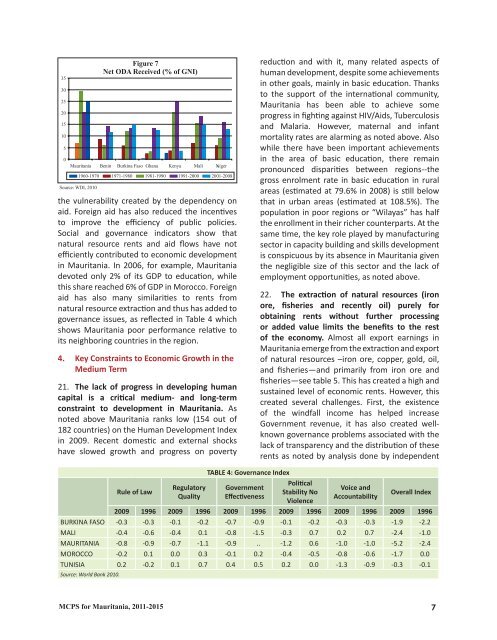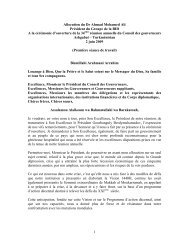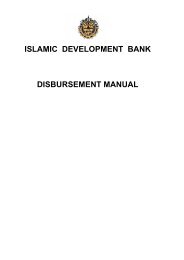Mauritania - Islamic Development Bank
Mauritania - Islamic Development Bank
Mauritania - Islamic Development Bank
Create successful ePaper yourself
Turn your PDF publications into a flip-book with our unique Google optimized e-Paper software.
the vulnerability created by the dependency on<br />
aid. Foreign aid has also reduced the incentives<br />
to improve the efficiency of public policies.<br />
Social and governance indicators show that<br />
natural resource rents and aid flows have not<br />
efficiently contributed to economic development<br />
in <strong>Mauritania</strong>. In 2006, for example, <strong>Mauritania</strong><br />
devoted only 2% of its GDP to education, while<br />
this share reached 6% of GDP in Morocco. Foreign<br />
aid has also many similarities to rents from<br />
natural resource extraction and thus has added to<br />
governance issues, as reflected in Table 4 which<br />
shows <strong>Mauritania</strong> poor performance relative to<br />
its neighboring countries in the region.<br />
4. Key Constraints to Economic Growth in the<br />
Medium Term<br />
21. The lack of progress in developing human<br />
capital is a critical medium- and long-term<br />
constraint to development in <strong>Mauritania</strong>. As<br />
noted above <strong>Mauritania</strong> ranks low (154 out of<br />
182 countries) on the Human <strong>Development</strong> Index<br />
in 2009. Recent domestic and external shocks<br />
have slowed growth and progress on poverty<br />
Rule of Law<br />
Regulatory<br />
Quality<br />
TABLE 4: Governance Index<br />
Government<br />
Effectiveness<br />
reduction and with it, many related aspects of<br />
human development, despite some achievements<br />
in other goals, mainly in basic education. Thanks<br />
to the support of the international community,<br />
<strong>Mauritania</strong> has been able to achieve some<br />
progress in fighting against HIV/Aids, Tuberculosis<br />
and Malaria. However, maternal and infant<br />
mortality rates are alarming as noted above. Also<br />
while there have been important achievements<br />
in the area of basic education, there remain<br />
pronounced disparities between regions--the<br />
gross enrolment rate in basic education in rural<br />
areas (estimated at 79.6% in 2008) is still below<br />
that in urban areas (estimated at 108.5%). The<br />
population in poor regions or “Wilayas” has half<br />
the enrollment in their richer counterparts. At the<br />
same time, the key role played by manufacturing<br />
sector in capacity building and skills development<br />
is conspicuous by its absence in <strong>Mauritania</strong> given<br />
the negligible size of this sector and the lack of<br />
employment opportunities, as noted above.<br />
22. The extraction of natural resources (iron<br />
ore, fisheries and recently oil) purely for<br />
obtaining rents without further processing<br />
or added value limits the benefits to the rest<br />
of the economy. Almost all export earnings in<br />
<strong>Mauritania</strong> emerge from the extraction and export<br />
of natural resources –iron ore, copper, gold, oil,<br />
and fisheries—and primarily from iron ore and<br />
fisheries—see table 5. This has created a high and<br />
sustained level of economic rents. However, this<br />
created several challenges. First, the existence<br />
of the windfall income has helped increase<br />
Government revenue, it has also created wellknown<br />
governance problems associated with the<br />
lack of transparency and the distribution of these<br />
rents as noted by analysis done by independent<br />
Political<br />
Stability No<br />
Violence<br />
Voice and<br />
Accountability<br />
Overall Index<br />
2009 1996 2009 1996 2009 1996 2009 1996 2009 1996 2009 1996<br />
BURKINA FASO -0.3 -0.3 -0.1 -0.2 -0.7 -0.9 -0.1 -0.2 -0.3 -0.3 -1.9 -2.2<br />
MALI -0.4 -0.6 -0.4 0.1 -0.8 -1.5 -0.3 0.7 0.2 0.7 -2.4 -1.0<br />
MAURITANIA -0.8 -0.9 -0.7 -1.1 -0.9 .. -1.2 0.6 -1.0 -1.0 -5.2 -2.4<br />
MOROCCO -0.2 0.1 0.0 0.3 -0.1 0.2 -0.4 -0.5 -0.8 -0.6 -1.7 0.0<br />
TUNISIA 0.2 -0.2 0.1 0.7 0.4 0.5 0.2 0.0 -1.3 -0.9 -0.3 -0.1<br />
Source: World <strong>Bank</strong> 2010.<br />
MCPS for <strong>Mauritania</strong>, 2011-2015 7






